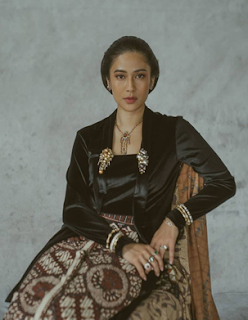Table of Content
1. Kebaya As Clothing From The Beginning Until Now With Various Creations
Some records show that the beginning of Kebaya was born in the late era of the Majapahit Kingdom and the beginning of the establishment of the Islamic Kingdom in Java. Majapahit based in Trowulan, currently located in Mojokerto Regency - East Java. Estimated time around the 15-16 century AD.It was women's clothing at that time which consisted of a
top as an outfit that covered the upper part of a woman's body. The outfit
complemented the kemben that was already known to the public at that time.
Kemben is a long cloth wrapped around the body covering the chest to the
ankles.
Such clothing was later named as Kebaya, in the early days
Kebaya was only worn by the palace or nobles. But along with the times, kebaya
is worn by most of the women without any restrictions on social or economic
status.
Increasingly, Kebaya is not merely a dress or a means to
cover body parts, but has become a part of showing identity and fashion
according to the era. As a fashion entity, women complete their appearance with
Jarit cloth, as a substitute for kemben. Jarit is a long cloth that has certain
motifs and patterns, jarit can be made of batik cloth, songket weaving cloth,
in some areas the sarong weaving. which
is adapted to the pattern and color of the kebaya.
Other accessories that accompany the kebaya dress are the
stagen which functions like a corset, improvisation, and as an
"interlude" between the kebaya and the jarit cloth. Then the hair
bun, as a crown accompanied by a shawl draped over the shoulders, and do not
miss the handheld fan.
2. Amid the current flowing fashion
Kebaya clothing, including objects that have undergone many modifications, produces various forms of variation that are more aimed at fashion. There are so many variations that the kebaya almost loses its original grip.2.1 Kebaya Encim/Kebaya Betawi
Looking back, the history of the Chinese community in Jayakarta, the Sultanate of Banten in the 16th century AD, gave birth to cultural acculturation, especially in women's clothing, known as Kebaya Encim. The word encim is absorbed from the Mandarin language 编曲 a greeting for married Chinese women.
 |
| Source : Google Image |
The hallmark of Kebaya Encim is not equipped with a bef, the right side and the left side of the kebaya are directly linked to meet in the middle of the front of the kebaya so that the neck of the kebaya forms a letter V. The shape of this kebaya model is simpler. Women in Javanese society in particular wear this type of kebaya in carrying out daily activities.
Due to the flow of trade and the movement of people, until the kebaya dress spread to various areas, especially port cities that were started by merchant routes, including Jayakarta (now Jakarta) where the Betawi people live, this is estimated to have occurred in the early period of the Sultanate of Banten around the 16th century.
In the 16th century, in Jayakarta, which was previously known as Sunda Kelapa, there were already Chinese settlements, when the Chinese began to enter and settle in Jayakata there is no definite record, but the Chinese had already inhabited several areas in Jakarta before the arrival of Europeans in Java.
Because of the long-standing social relationship between the Chinese and the local community (Betawi), it is not surprising that Betawi social life is heavily influenced by Chinese culture, including the kebaya. The influence of acculturation on Chinese culture gave birth to variants of the Kebaya Encim or Kebaya Betawi types. This was revealed in the book History of Jakarta written by Uka Tjandrasasmita.
The hallmark of Kebaya Encim is a folding collar, continuous folds pointing downwards and stopping at the front three quarters. The back of the Kebaya Encim reaches below the pelvis but does not cover the buttocks completely, while the front is lower with the meeting of the two sides slightly tapered.
Most of the Kebaya encim have a border decoration on the front left and right sides, and a border decoration at the end of the forearm. However, there are also Kebayas without border decorations, so the kebaya is left plain. The preferred fabrics for making Kebaya Encim are cotton and chiffon fabrics. Both types of fabrics have a soft texture and fall well, and some like Kebaya Encim are made of fibrous material.
2.2 Kebaya Kutubaru
The distinctive feature of this kebaya is that on the front it is equipped with a bef (a piece of cloth) which is sewn on the left side of the front edge of the kebaya. The function of this bef is to cover the chest by linking the other side of the bef to the right edge of the kebaya using a safety pin. This type of kebaya is more formal, only worn at certain moments. At first, this kebaya model was only worn by the nobility. |
| Source : Google Image |
- Kebaya with bef, buttoned with brooch
- Subordinates use Jarit batik, songket weaving, or sarong weaving.
- Apply Stagen as a kebaya interlude with jarit.
- Ear decoration in the form of studs.
- Hair braid/ hair bun.
- Shawl draped over the shoulder.
- Hand-held fan
Get rewarded as a contributor*
WFH projects can be done from anywhere, if you are suitable
and approved you can work on the projects offered, the rewards are not bad
between 100 – 250 US$. Before viewing and selecting available projects, you
register first at this link.
Projects (short- or long-term ); Search and Social Media
Evaluation; Translation and Transcription Services; Linguistic Specialties; Speech
Evaluation; Micro Tasks; Surveys and Data Collection; Data
Annotation (for images, audio, video, and more)
Post a Comment for "Kebaya Model Creations That Characterize the Region In Indonesia"